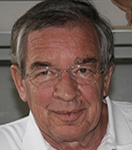Theme: Integrating the New Era in Radiology & Imaging
Renowned Speakers
Radiology 2016
ConferenceSeries Ltd invites all the participants from all over the world to attend “5th International Conference on Radiology & Imaging”. During September 19-20, 2016 in Las Vegas, USA which includes prompt Keynote presentations, Oral talks, Poster presentations and Exhibitions.
Radiology 2016 directs towards addressing main issues as well as future strategies of Radiology. This is going to be the largest and most promising international conference where the program includes Clinical Radiologists, Registered Nurses, Nurse practitioners and the entire medical team involved in patient care, researchers, professional, early career individuals and patient advocates who wish to learn principles of Radiology and its highly branched areas well as decision makers will come to discuss and debate on various aspects of the challenges, risks and investment opportunities throughout the complete information of Radiology. This conference deals with the unique techniques of radiology and its innovative strategies. Radiology-2016 will also provide two days of discussion on methods and strategies related to management and quality improvement of Cancer and as well as to explore the new ideas and concepts on global scale and other minimally invasive treatments.
Track 1: Radiation Oncology
Radiation Oncology encompasses all aspects of research that impacts on the treatment of cancer using radiation. It publishes findings in molecular and cellular radiation biology, radiation physics, radiation technology, and clinical oncology.
The field of radiation oncology covers the integration of radiation therapy into multimodal treatment approaches. Radiation Oncology provides an open access forum for researchers and clinicians involved in the management and treatment of cancer patients, bringing together the latest research and advances in the field. Advances in treatment technology, as well as improved understanding of the underlying biological resistance mechanisms, will further strengthen the role of radiation oncology.
Related Conferences
5th Radiology And Imaging Conference, September 19-20 2016, Las Vegas, USA; Medical Imaging conference May 09-10 2016, Chicago, USA ; 2nd Medical and Biophysics Conference, November 17-18 2016, Istanbul, Turkey; International Radiography Conference, November 17-18 2016, Dubai, UAE; Nuclear Medicine and Radiation Therapy Conference, July 14-15 2016, Cologne, German; Swiss Congress of Radiology, May 26-28 2016, Bern, Switzerland; 15th Annual Emergency Radiology Symposium: What You Need to Know to Get You through the Night November 15-18 2016, Miami Beach, USA; World Congress of Thoracic Imaging, June 18-21 2016, Boston, USA;18th International Conference on the Use of Computers in Radiation Therapy, June 27-30 2016, London, UK; World Congress of Thoracic Imaging, June 18-21 2016, Boston, USA; Imaging in Israel June 05-08 2017, Jerusalem, Israel
Track 2: Advances in Cancer Detection
Imaging has become essential in all aspects of cancer care, from disease detection and characterization, to treatment response assessment and post treatment surveillance. Recent progress in imaging technology has presented new opportunities for improving clinical care. Interventional oncology, employing minimally invasive, image-guided techniques, is assuming an increasingly large role in treating cancer and its complications. This scientific session will focus on various imaging technique and it impact on disease diagnosis such as Fluorescence Imaging Techniques, Digital Mammography & Computer-Aided Detection System, Electrical Impedance Scanning, Nanotechnology based Detection and Tumour Microarrays.
Related Conferences
5th International Conference on Radiology and Imaging , September 19-20, 2016, USA; International Conference on Nuclear Medicine and Radiation Therapy , July 14-15, 2016,Germany; International Conference on Medical Imaging and Diagnosis Conference, May 09-10, USA; 2nd International Conference on Medical Physics and Biophysics , November 03-05, 2016, Turkey; International Conference on Radiography , November 17-18, 2016,UAE; International Conference on Pancreatic and Colorectal Cancer, March 29-30, 2016,USA; 2ndInternational Conference on Prostate Cancer and Treatment, May 05-07, 2016, USA; Experts Meeting onGynaecologic Oncology, May 19-21, 2016, USA; Cancer Diagnostics Conference & Expo, June 13-15, 2016, Italy; 14th World Congress on Cancer Therapy, Dec 08-10, 2016, USA; World Congress on Breast CancerControversies, Oct 22-24, 2015, Australia; Breast MR Imaging Conference, Oct 20-24, 2015, USA; Breast MRwith Biopsy Conference, Nov 16-17, 2015,USA; Advances in Cancer Immunotherapy Conference,Sep 18, 2015, USA; Breast Imaging Conference, Oct 12-14, 2015,USA; Digital Radiography Conference,Oct 09, 2015, UK. 12th Cancer Conferences Europe September 26-28, 2016 London, UK. 12th Oncology Conferences Europe September 26-28, 2016 London, UK, 12th Cancer Science Events Europe September 26-28, 2016 London, UK,Cancer Global Conferences Middle East November 21-23, 2016 Dubai, UAE, Oncology ConferencesNovember 21-23, 2016 Dubai, UAE, Worldwide Cancer EventsNovember 21-23, 2016 Dubai, UAE, Breast Cancer Conferences October 03-05, 2016 London, UK, Women’s Health Conferences October 03-05, 2016 London, UK
Track 3: Industrial Forum: Radiology
Industrial radiologic technicians take x-rays of manufactured products, such as gas and oil pipelines, boilers and pipes, to determine their levels of durability, quality and safety. According to the Conference of Radiation Control Program Directors, industrial radiologic technicians must attend a radiation safety course, have on-the-job training and pass a written test, as required by the Nuclear Regulatory Commission (NRC) and individual states. Successful completion of these requirements can lead to professional certification as an industrial radiographer. In general, an associate's program in this field covers topics in radiation biology and physics, instrumentation, and, most importantly, safety procedures. Many programs also offer courses in industrial radiology. Some schools offer certificate programs specifically in industrial radiologic technology.
Related Conferences
5th Radiology and Imaging Conference, September 19-20 2016, Las Vegas, USA; 2nd Medical and BiophysicsConference, November 17-18 2016, Istanbul, Turkey; International Radiography Conference, November 17-18 2016, Dubai, UAE; Medical Imaging and Diagnosis Conference, May 09-10 2016, Chicago, USA ; Nuclear Medicine and Radiation Therapy Conference, July 14-15 2016, Cologne, Germany; Imaging in Israel, June 05-08 2017, Jerusalem, Israel; 18th International Conference on the Use of Computers in Radiation Therapy, June 27-30 2016, London, UK; World Congress of Thoracic Imaging, June 18-21 2016, Boston, USA; Swiss Congress of Radiology, May 26-28 2016, Bern, Switzerland; 15th Annual Emergency Radiology Symposium: What You Need to Know to Get You Through the Night November 15-18 2016, Miami Beach, USA
Track 4: Radiology Trends and Technology
Radiology imaging is the technique and process of creating visual representations of the interior of a body for clinical radiology analysis and medical intervention. Medical imaging seeks to reveal internal structures hidden by the skin and bones, as well as to diagnose and treat disease.
Radiology imaging it is part of biological imaging and incorporates radiology which uses the imaging Interventional Radiology technologies of x-ray radiography, magnetic resonance imaging, radiological markers, medical ultrasonography or ultrasound, endoscopy, elastography, tactile imaging, thermography, medical photography and nuclear medicine functional imaging techniques as positron emission tomography.
Related Conferences
5th Radiology And Imaging Conference, September 19-20 2016, Las Vegas, USA; Medical Imaging and Diagnosis Conference, May 09-10 2016, Chicago, USA ; International Radiography Conference, November 17-18 2016, Dubai, UAE.; Nuclear Medicine and Radiation Therapy Conference, July 14-15 2016, Cologne, Germany; 2nd Medical and Biophysics Conference, November 17-18 2016, Istanbul, Turkey; Swiss Congress ofRadiology, May 26-28 2016, Bern, Switzerland; 15th Annual Emergency Radiology Symposium: What You Need to Know to Get You through the Night, November 15-18 2016, Miami Beach, USA; Imaging in Israel June 05-08 2017, Jerusalem, Israel; 18th International Conference on the Use of Computers in Radiation Therapy, June 27-30 2016, London, UK; World Congress of Thoracic Imaging, June 18-21 2016, Boston, USA; Medical Imagingand Diagnosis Conference, May 09-10 2016, Chicago, USA
Track 5: Radiographic Testing
Radiology is a medical specialty event that uses imaging to diagnose and treat disease seen within the body.Radiologists use a variety of imaging techniques such as X-ray radiography, ultrasound, computed tomography (CT), nuclear medicine including positron emission tomography (PET), and magnetic resonance imaging (MRI) to diagnose and/or treat diseases. Personalized medicine or PM is a medical model that proposes the customization of healthcare, and Interventional radiology is the performance of (usually minimally invasive) medical procedures with the guidance of imaging technologies.
Related Conferences
5th Radiology And Imaging Conference, September 19-20 2016, Las Vegas, USA; Medical Imaging and Diagnosis Conference, May 09-10 2016, Chicago, USA ; 2nd Medical and Biophysics Conference, November 17-18 2016, Istanbul, Turkey; International Radiography Conference, November 17-18 2016, Dubai, UAE; Nuclear Medicine and Radiation Therapy Conference, July 14-15 2016, Cologne, German; Swiss Congress ofRadiology, May 26-28 2016, Bern, Switzerland; 15th Annual Emergency Radiology Symposium: What You Need to Know to Get You through the Night November 15-18 2016, Miami Beach, USA; World Congress of Thoracic Imaging, June 18-21 2016, Boston, USA;18th International Conference on the Use of Computers in Radiation Therapy, June 27-30 2016, London, UK; World Congress of Thoracic Imaging, June 18-21 2016, Boston, USA; Imaging in Israel June 05-08 2017, Jerusalem, Israel
Track 6: Breast Radiography
The participants will get information regarding the high risk screening patient who is genetically predisposed. The tools and methods for breast screening will be discussed and the composition of a multidisciplinary team designed for such screening will be presented. The presenter will discuss the makeup of breast tissue imaging, how is breast density determined, and who has dense breast. The subject of how dense breast tissue is imaged and the reporting is done will also be covered.
Related Conferences
International Radiography Conference, November 17-18 2016, Dubai, UAE ; Medical Imaging and Diagnosis Conference, May 09-10 2016, Chicago, USA ; 5th Radiology And Imaging Conference, September 19-20 2016, Las Vegas, USA; Nuclear Medicine and Radiation Therapy Conference, July 14-15 2016, Cologne, Germany; 2nd Medical and Biophysics Conference, November 17-18 2016, Istanbul, Turkey; 18th International Conference on the Use of Computers in Radiation Therapy, June 27-30 2016, London, UK; World Congress of Thoracic Imaging, June 18-21 2016, Boston, USA; 15th Annual Emergency Radiology Symposium: What You Need to Know to Get You through the Night November 15-18 2016, Miami Beach, USA; Imaging in Israel June 05-08 2017, Jerusalem, Israel; Swiss Congress of Radiology, May 26-28 2016, Bern, Switzerland
Track 7: PET/MRI versus PET/CT Hybrid
Diagnostic radiology helps health care professionals see structures inside your body. Doctors that specialize in the interpretation of these images are called diagnostic radiologists. Using the diagnostic images, the radiologist or other physicians can often:
The most common types of diagnostic radiology exams include Computed tomography (CT), also known as a CAT scan (computerized axial tomography), including CT angiography, Fluoroscopy, including upper GI and barium enema, Magnetic resonance imaging (MRI) and Mammography, magnetic resonance angiography (MRA), Nuclear medicine, which includes such tests as a bone scan, thyroid scan, and thallium cardiac stress test, Plain x-rays, which includes chest x-ray, Positron emission tomography, also called PET imaging or a PET scan and Ultrasound.
Related Conferences
5th Radiology And Imaging Conference, September 19-20 2016, Las Vegas, USA; 2nd Medical and BiophysicsConference, November 17-18 2016, Istanbul, Turkey; International Radiography Conference, November 17-18 2016, Dubai, UAE.; Medical Imaging and Diagnosis Conference, May 09-10 2016, Chicago, USA ; Nuclear Medicine and Radiation Therapy Conference, July 14-15 2016, Cologne, Germany; World Congress of Thoracic Imaging, June 18-21 2016, Boston, USA; 15th Annual Emergency Radiology Symposium: What You Need to Know to Get You through the Night November 15-18 2016, Miami Beach, USA; Imaging in Israel June 05-08 2017, Jerusalem, Israel; Swiss Congress of Radiology, May 26-28 2016, Bern, Switzerland; 18th International Conference on the Use of Computers in Radiation Therapy, June 27-30 2016, London, UK
Track 8: Advances in Imaging
Section 135(a) of the Medicare Improvements for Patients and Providers Act of 2008 (MIPPA) amended section 1834(e) of the Social Security Act .MIPPA specifically defines advanced diagnostic imaging procedures as including diagnostic magnetic resonance imaging (MRI), Medical Sonography, Body Imaging, Molecular imaging, computed tomography (CT), and nuclear medicine body imaging such as positron emission tomography (PET). The law also authorizes the Secretary to specify other diagnostic imaging services in consultation with physician specialty organizations and other stakeholders.
MIPPA expressly excludes from the accreditation requirement x-ray, ultrasound, Body Imaging, Diagnostic Medical Sonography and fluoroscopy procedures. The law also excludes from the CMS accreditation requirement diagnostic and screening mammography which are subject to quality oversight by the Food and Drug Administration under the Mammography Quality Standards Act.
Related Conferences
Nuclear Medicine and Radiation Therapy Conference, July 14-15 2016, Cologne, Germany; 5th Radiology And Imaging Conference, September 19-20 2016, Las Vegas, USA; Medical Imaging and Diagnosis Conference, May 09-10 2016, Chicago, USA ; 2nd Medical and Biophysics Conference, November 17-18 2016, Istanbul, Turkey; International Radiography Conference, November 17-18 2016, Dubai, UAE; World Congress of Thoracic Imaging, June 18-21 2016, Boston, USA; 15th Annual Emergency Radiology Symposium: What You Need to Know to Get You through the Night November 15-18 2016, Miami Beach, USA; Imaging in Israel June 05-08 2017, Jerusalem, Israel; Swiss Congress of Radiology, May 26-28 2016, Bern, Switzerland; 18th International Conference on the Use of Computers in Radiation Therapy, June 27-30 2016, London, UK
Track 9: Magnetic Resonance Imaging
Medical images are pictures of distributions of physical attributes captured by an image acquisition system. Most of today’s images are digital. They may be post processed for analysis by a computer-assisted method. Medical images come in one of two varieties: Projection images project a physical parameter in the lung disease in human body on a 2D image, while slice images produce a one-to-one mapping of the measured value. International radiology conferences explore the new technologies in medical images. Medical images may show anatomy including the pathological variation of anatomy if the measured value is related to it or physiology when the distribution of substances is traced. X-ray imaging, CT, Dynamic MRI, nuclear imaging, ultrasound imaging, and Cellular imaging is the study of living cells using time-lapse microscopy, photography. The discussion focuses on the relationship between the imaged physical entity and the information shown in the image, as well as on reconstruction methods and the resulting artifacts
Related Conferences
Medical Imaging and Diagnosis Conference, May 09-10 2016, Chicago, USA; 5th Radiology and Imaging Conference, September 19-20 2016, Las Vegas, USA; 2nd Medical and Biophysics Conference, November 17-18 2016, Istanbul, Turkey; International Radiography Conference, November 17-18 2016, Dubai, UAE.; Nuclear Medicine and Radiation Therapy Conference, July 14-15 2016, Cologne, Germany; Imaging in Israel June 05-08 2017, Jerusalem, Israel; Swiss Congress of Radiology, May 26-28 2016, Bern, Switzerland; World Congress of Thoracic Imaging, June 18-21 2016, Boston, USA; 15th Annual Emergency Radiology Symposium: What You Need to Know to Get You through the Night November 15-18 2016, Miami Beach, USA; 18th International Conference on the Use of Computers in Radiation Therapy, June 27-30 2016, London, UK
Track 10: Ultrasound
Ultrasound Registry Review course provides a comprehensive review for successful certification exam completion. The Obstetrics & Gynecology registry review is taught by leading experts in the ultrasound profession and includes interactive lectures, case studies, and mock registry exams using an interactive Audience Response System. Attend The OB-GYN Ultrasound Registry Review workshop as a method to assess areas of weakness to effectively plan your exam preparation or attend the Obstetrics and Gynecology registry review as the final comprehensive review before taking the exam.
Related Conferences
5th Radiology and Imaging Conference, September 19-20 2016, Las Vegas, USA; Medical Imaging and Diagnosis Conference, May 09-10 2016, Chicago, USA ; 2nd Medical and Biophysics Conference, November 17-18 2016, Istanbul, Turkey; International Radiography Conference, November 17-18 2016, Dubai, UAE.; Nuclear Medicine and Radiation Therapy Conference, July 14-15 2016, Cologne, Germany; Swiss Congress ofRadiology, May 26-28 2016, Bern, Switzerland; World Congress of Thoracic Imaging, June 18-21 2016, Boston, USA; 15th Annual Emergency Radiology Symposium: What You Need to Know to Get You through the Night November 15-18 2016, Miami Beach, USA; Imaging in Israel June 05-08 2017, Jerusalem, Israel; 18thInternational Conference on the Use of Computers in Radiation Therapy, June 27-30 2016, London, UK
Track 11: Mammography
Bremsstrahlung is the major influence in most x-ray tubes with the exception of x-ray tubes for mammography. The purpose of mammography is to detect small, nonpalpable lesions in the breast. This requires a much higher image quality than normal x-ray imaging with respect to contrast and spatial resolution. Since contrast and resolution are affected by scattering, mammography tubes reduce bremsstrahlung by suitable filtering. Furthermore, mammography tubes use a material (Molybdenum) that produces an almost monochrome x ray with peak energies around 17 to 19 keV. This would be unwanted in regular x-ray imaging as most—if not all—of the radiation would be absorbed and not reach the receptor. For the breast, however, the use of low-energy beams increases the contrast between the subtle differences of different tissues. Using an (almost) monochromatic beam will also reduce scatter, which again increases contrast.
Related Conferences
International Radiography Conference, November 17-18 2016, Dubai, UAE; Medical Imaging and Diagnosis Conference, May 09-10 2016, Chicago, USA ; 5th Radiology and Imaging Conference, September 19-20 2016, Las Vegas, USA; Nuclear Medicine and Radiation Therapy Conference, July 14-15 2016, Cologne, Germany; 2nd Medical and Biophysics Conference, November 17-18 2016, Istanbul, Turkey; Imaging in Israel June 05-08 2017, Jerusalem, Israel; 18th International Conference on the Use of Computers in Radiation Therapy, June 27-30 2016, London, UK; Swiss Congress of Radiology, May 26-28 2016, Bern, Switzerland; World Congress of Thoracic Imaging, June 18-21 2016, Boston, USA; 15th Annual Emergency Radiology Symposium: What You Need to Know to Get You through the Night November 15-18 2016, Miami Beach, USA
Conference Series LLC Ltd invites all participants across the world to join 5th International Conference on Radiology & Imaging which is going to be held during September 19-20, 2016 Las Vegas, USA.
Radiology2016 is a trending event which brings together efficient international academic scientists, young researchers, and students making the congress a perfect platform to share experience, gain and evaluate emerging technologies in Radiology across the globe. Initiation of cross-border co-operations between scientists and institutions will be also facilitated. The Main theme of the Conference is “An Insight into the Advanced Technologies in Radiology and Imaging”. This conference provides three days of great opportunity to discuss on recent approaches and advancements for development of new techniques for global health
Conference Series LLC Ltd organizes a conferences of 1000+ Global Events inclusive of 300+ Conferences, 500+ Upcoming and Previous Symposiums and Workshops in USA, Europe & Asia with support from 1000 more scientific societies and publishes 700+ Open access journals which contains over 30000 eminent personalities, reputed scientists as editorial board members
Target Audience:
- Radiology Students, Scientists
- Radiology Researchers
- Radiology Faculty
- Medical Colleges
- Radiology Associations and Societies
- Business Entrepreneurs
- Training Institutes
- Software developing companies
- Manufacturing Medical Devices Companies
- Data Management Companies
Overall Market of Radiology
83 conferences were held internationally in the year 2015 and the number is going up. The Expected scenario of Radiology is also going up owing to the analytical surveys reported.
The wanton for radiological higher studies is also high. The number of expected radiological specialists is increasing owing to the low risk factored options laid out by Interventional Radiology. Numbers from the American College of Radiology suggests, there were about 1,100 fellows competing for approximately 1,115 open positions in 2014. This suggests the huge scope of Radiology and its wide Research arenas.
There are approximately 1,900 radiology groups today, down from approximately 2,100 just three years ago. Though the statistics may seem to be fluctuating the actual figurines have somewhat different conclusions. Groups merging and hence enhancing their diversity are an excellent indication of Globalization. This improves research scope and opens doors to a huge potential market.
The numbers in global trends are seemingly on the rise. The global radiology information systems market is expected to reach $722.1 million by 2019 from $501.1 million in 2014, at a CAGR of 7.6% from 2014 to 2019. The global digital radiology market was estimated at $9.7 billion in 2012 and is expected to reach $13.3 billion by 2018, growing at CAGR of 5.4%.
If we look at the demographics, by 2030, it's estimated that 40% of the population will have some type of cardiovascular disease, 8 million more people will have coronary heart disease, and 4 million more will have strokes. Radiology will play a big role in the management of those diseases. Reimbursement per study will probably go down, but in some ways that's a good thing. Specifically, the value of imaging is clearly there, it has to be made more affordable if contribution to patient care should be continued
Magnetic resonance imaging (MRI) has been one of the more frequently used medical imaging modalities – about 30 million MRI scans are estimated to be performed annually. MRI use in chest, vascular, breast and cardiac imaging procedures has been increasing,” according to Kalorama Information. The information provided by Reports n Reports forecasts growth in the MRI market to approach $5.25 billion by 2018. The current magnetic resonance imaging industry is producing over 2,000 units per year. The global market for these systems values $4.13 billion, as of the first quarter of 2013, and is expected to grow at a CAGR of 4.56 percent reaching approximately around $5.24 billion by 2018,” according to a summary of the report.
“As of March 2013, North America dominates the market with nearly 40 percent share, followed by Europe due to technological developments for effective diagnostics and rapidly aging population. However, Asia is slated to grow at a high CAGR of 5.2 percent over the analysis period. Improved spending capability and physicians inclination towards MR imaging over other conventional medical imaging modalities is fuelling demand for MRI across this region. Asia holds enormous growth potential, particularly from countries with large population base such as China and India. The demand is anticipated primarily from private hospitals compared to public hospitals.
The adoption of MR imaging equipment market is also likely to grow owing to the rising incidences of cardiac diseases, neurological and oncological cases in the region. The cost and limited availability of helium for cooling MRI devices has been a concern for this market as well as healthcare reforms in the U.S. that are causing a decrease in reimbursements. However, ReportsnReports does not expect these challenges to hinder the market over the forecast period ending in 2018.
The global medical imaging systems market was valued at USD 25,710.5 million in 2013 and is expected to grow at a CAGR of 5.7 percent over the next six years according to a report by Grand View Research, a market research and consulting firm. Moreover, growing global geriatric population base that are more susceptible to cardiovascular, orthopedic and respiratory diseases and increasing market penetration rates of advanced medical imaging systems and PACS (picture archiving and communication systems) are expected to drive market growth during the forecast period.”
North America owing to the presence of sophisticated health care infrastructure, high end-user purchasing power and reimbursement framework, dominated the overall market in 2013 at over 32.0 percent according to Grand View Research.
Asia Pacific is expected to exhibit the highest CAGR of 7.5 percent from 2014 to 2020.
Scope and Importance of Radiology Research
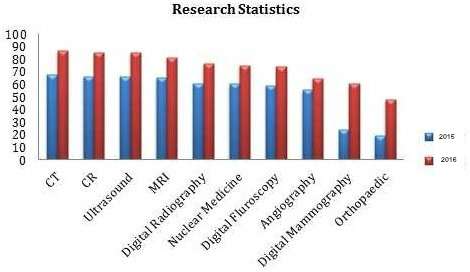
Although much of what occupies the radiology literature is still descriptive, journals are more often publishing articles on hypothesis-driven research. There are many more articles that reflect some pre - study consideration of experimental design and analysis, and this is a trend that seems to be progressing. There now is greater availability of extramural funding from federal, foundation, and commercial sources. Speciality departments participate in extramurally funded research.
In 1998, all NIH institutes and centers combined funded an estimated $339 million for over 1,500 biomedical imaging projects—one-third to one-half of this amount was granted to radiology departments (Baum S, Croft B; written communications; 1999). Although there has been a growing concentration of extramural federal funding among a handful of radiology departments, fully half of the 127 university radiology departments in the United States received some NIH funding in 1998. Increasing numbers of speciality departments are participating in commercially supported multi institutional clinical trials both as a way for more of their faculty to participate in clinical research and as a source of revenue to support investigator-initiated research.
The National Cancer Institute recently awarded a 5-year grant for a national network to conduct multiinstitutional, multidisciplinary clinical trials of diagnostic imaging and image-guided therapeutic technologies—the American College of Radiology Imaging Network (ACRIN) .The greatest difference between 1974 and 1999 is the scope of technology that now can be brought to bear for research.
Departments with laboratory programs now use dedicated computer-based modalities such as CT, magnetic resonance (MR), US, and nuclear scintigraphic techniques to investigate disease states.
More advanced centres are beginning to elucidate how non-invasive imaging can be used to investigate subcellular processes and aid in gene therapy.
Radiology researchers are less isolated than they previously were, with much of the best work representing multidisciplinary collaborations with other specialists and experts in study design, across departments and institutions. Health services research is the multidisciplinary field of scientific investigation that studies how social factors, financing systems, organizational structures and processes, health technologies, and personal behaviours affect access to health care, the quality and cost of health care, and ultimately our health and well-being. Its research domains are individuals, families, organizations, institutions, communities, and populations.
Las Vegas - The Apt Venue
- Industry revenue is expected to rise by 1.5% to $70.6 billion in 2015-16.
- $ 71 billion Revenue.
- Annual Growth – 1.1%
- Owing to tremendous demands United States of America is facing huge demands for Radiographers.
- Total 3,174 consultant clinical radiologists in post in USA
- 6.0 clinical radiologists per 100,000 of the population in the USA
- It is funded to 1701 million dollars
- There are 326 Radiological Professionals in Las Vegas
- There are 75 medical centres performing radiological procedures in Las Vegas alone
Societies and Associations Associated with Radiology Research
American Academy of Oral and Maxillofacial Radiology (AAOMR)
American Association of Physicists in Medicine (AAPM)
American Association for Women Radiologists (AAWR)
American Board of Nuclear Medicine (ABNM)
American Board of Radiology (ABR)
American College of Medical Physics (ACMP)
American College of Nuclear Physicians (ACNP)
American College of Radiology (ACR)
American College of Radiation Oncology (ACRO)
American Healthcare Radiology Administrators (AHRA)
American Institute of Ultrasound in Medicine (AIUM)
American Medical Association (AMA)
American Nuclear Society (ANS)
American Osteopathic College of Radiology (AOCR)
American Radium Society (ARS)
American Registry of Diagnostic Medical Sonographers (ARDMS)
American Registry of Radiologic Technologists (ARRT)
American Roentgen Ray Society (ARRS)
American Society for Gastrointestinal Endoscopy (ASGE)
American Society for Therapeutic Radiology and Oncology (ASTRO)
American Society of Echocardiography (ASE)
American Society of Emergency Radiology (ASER)
American Society of Head and Neck Radiology (ASHNR)
American Society of Interventional and Therapeutic Neuroradiology (ASITN)
American Society of Neuroradiology (ASNR)
American Society of Nuclear Cardiology (ASNC)
American Society of Radiologic Technologists (ASRT)
American Society of Spine Radiology (ASSR)
American Telemedicine Association (ATA)
Association of Residents in Radiation Oncology (ARRO)
Association of Telemedicine Service Providers (ATSP)
Association of University Radiologists (AUR)
Association of Vascular and Interventional Radiographers (AVIR)
Canadian Association of Radiologists (CAR)
Canadian Organization of Medical Physicists (COMP)
Clinical Magnetic Resonance Society (CMRS)
Computer Assisted Radiology and Surgery (CARS)
International Association of Dentomaxillofacial Radiology (IADMFR)
International Consortium for Medical Imaging Technology (ICMIT)
International Society for Magnetic Resonance in Medicine (ISMRM)
International Society of Radiographers & Radiological Technologists (RSRRT)
International Society of Radiology (ISR)
International Society of Ultrasound in Obstetrics and Gynecology (ISUOG)
Musculoskeletal Ultrasound Society
North American Society for Cardiac Imaging (NASCI)
Nuclear Medicine Technology Certification Board (NMTCB)
Radiological Society of North America (RSNA)
Radiology Business Management Association (RBMA)
Radiation Research Society
Radiation Therapy Oncology Group (RTOG)
Society of Breast Imaging (SBI)
Society for the Advancement of Women's Imaging (SAWI)
Society for Cardiac Angiography and Interventions (SCAI)
Society for Cardiovascular Magnetic Resonance
Society for Computer Application in Radiology (SCAR)
Society for Pediatric Radiology (SPR)
Society of Cardiovascular & Interventional Radiology (SCVIR)
Society of Cardiovascular Magnetic Resonance (SCMR)
Society of Computed Body Tomography and Magnetic Resource (SCBT/MR)
Society of Diagnostic Medical Sonographers (SDMS)
Society of Gastrointestinal Radiologists (SGR)
Society of Nuclear Medicine (SNM)
Society of Radiology Oncology Administrators (SROA)
Society of Radiologists in Ultrasound (SRU)
Society of Radiology Oncology Administrators (SROA)
Society of Skeletal Radiology (SSR)
Society of Thoracic Radiology (STR)
Institutions Associated with Radiology Research
Agilent technologies
Algotec
Allscripts
All star x-ray, inc
Amber diagnostics
Amd
American medical sales
AmicasAtkina medical
Atlantis worldwide
Auntminnie
Aurora advanced breast imaging
Barco Holding b.V
B.v. Cyclotron virje universiteit
Cannon medical
Carestream
Centro di Radiologia Carpinelli SRL
Cerner corporation
Cook medical
Covidien
Del medical systems group
Diagnostix plus
Dunlee
Duynamic imaging specialists, llc
Eastman kodak
Eizo
Elekta
Emageon solutions
Emed Technologies
Emergence teleradiology
Epic systems
Esaote S.P.A.
Excel imaging
Fischer bloom
Fischer imaging
Fonar
Fuji
Fuji Medical Systems
G.e. healthcare
Hitachi medical systems america, inc
Hologic
Holorad
Icroo
Images on call
Imaging equipments
Imed srl
Impac medical systems
Infimed
Istituto di radiologia ed ecografia del dott. Giuseppe deriu srl
Icrco
Idetec medical imaging
Jones xray
Konica medical
Lupica medical systems
Mallinckrodt
Mckesson Corporation
Mds nordian
Medical imaging imco, inc
Medison
Medrad
Medx
Merge healthcare
Metaltronica srl
Mistsubishi imaging
Mir
Misys Radiology
Mysono
Ncd company
Nighthawk teleradiology services
Nordion
Oni
Orex computed radiography
Ozark Imaging
Phillips healthcare
Phillips medical systems
Planmed
R2 technology
Radiforce
Radisphere
Radwork
Scimage
Sectra imtec ab
Seimens healthcare ag
Shared imaging
Shimadzu medical systems
Sonosite
Sound eklin
Swissray International
Teleradiology solutions
Terarecon
Toshiba medical systems
Triangle x-ray co.
Umg/del medical
Us medical
Varian Medical Systems Nederland b.V.
Virtual radiologic
Vision radiology
Vital images
Wolverine x-ray
Zonare
Market Value on Radiology Research
The global teleradiology market was worth US$0.92 billion in 2012. It has been predicted that this market will grow at a CAGR of 22.3% from 2013 to 2019, eventually reaching an estimated market value of US$3.78 billion. These projections are provided in a market research report titled Teleradiology Market - Global Industry Analysis, Size, Share, Growth, Trends and Forecast, 2013-2019, released by market intelligence firm Transparency Market Research.
Despite serious reimbursement pressure, the imaging-center market appears to be on the move again, adding 131 sites as of the first quarter of 2012. While this year’s expansion does not approach the tremendous growth rates of the period between 2000 and 2008, when the market more than doubled (from 3,068 centers to 6,431), it does return the sector to slightly more than the size it was in 2008 (6,514 centers), before it contracted.¹ Why the total number of sites in 2009 year’s report is 691 more than 2008’s total, instead of the 131 reported .Due to a discovery data source of 560 diagnostic imaging centers that had not been counted before, it turns out that the market is 560 centers larger than previously thought. The total size of the market at 7,074 sites, which includes the 560 previously unreported imaging-center sites, as well as the 131 new sites.
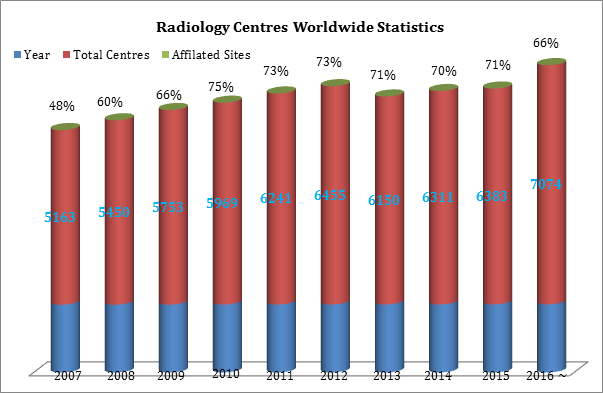
Market Trends in United States of America
Interventional Radiology and Cardiology
The European market for interventional radiology and cardiology is heading towards maturity, especially in Western Europe. Although the economic slowdown and fewer orders had a negative impact on revenues in 2012, it is expected that expanding applications of interventional systems and the popularisation of hybrid solutions will drive market growth over the 2013-2017 period
Market Trends in Europe Interventional Radiology and Cardiology, finds that the market earned approximately $336.7 million in 2012 and estimates this to reach $352.6 million in 2016. Novel applications, the demand for hybrid solutions and the need for new systems in Eastern Europe will fuel market growth.
One of the key trends in medicine is the steady replacement of open surgeries with minimally invasive procedures. Hybrid operating rooms support this trend.
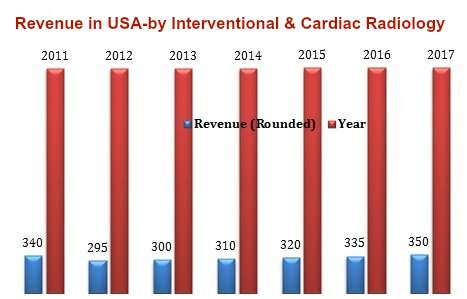
Remote radiology market Teleradiology
The expansion in the use of teleradiology services has been one of the most controversial issues in the radiology market over the past few years. But if a new report from healthcare technology research and advisory firm CapSite is any indication, the controversy isn't affecting interest in remote radiology.
After surveying more than 700 U.S. healthcare provider organizations, CapSite found that nearly half of those who utilize remote radiology services signed either new contracts or renewals for those services in the past year. In addition, the Williston, VT-based firm found that 21% of survey respondents are planning to evaluate remote radiology over the next 18 months.
CapSite also found significant utilization of remote radiology services for final reads.
Of the sites included in the report, 336 had an annual imaging exam volume of 50,000 or less. There were 145 survey participants with an exam volume of 50,001 to 100,000, 86 with an exam volume of 100,001 to 150,000, 50 with an exam volume of 150,001 to 200,000, and 66 with an exam volume of more than 200,000 exams.
When asked who is responsible for reading radiology images at their facility, 30% of respondents indicated that they had facility-employed radiologists with a supplemental remote radiology group. Nineteen percent utilized a remote radiology group, while an additional 19% had facility-employed radiologists. The remaining 32% indicated another arrangement.
The remote radiology reading market is dominated by two firms: NightHawk Radiology Services of Scottsdale, AZ, and Virtual Radiologic of Eden Prairie, MN; the rest of the market is highly fragmented, according to CapSite.
"Beyond those two, it drops off very quickly," said CapSite vice president Gino Johnson. "That makes it a very unique market in terms of the dynamics and the amount of competition that exists."
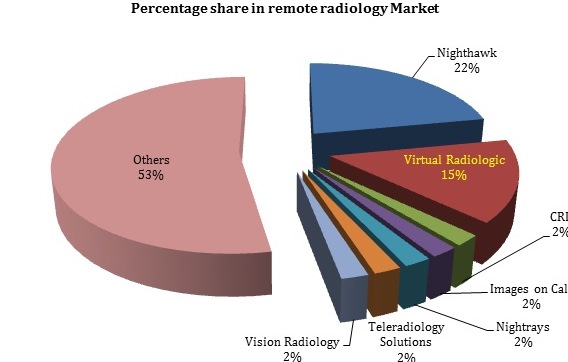
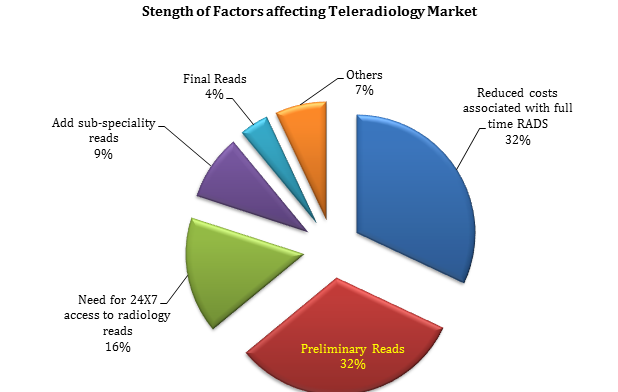
Variation was also seen in how facilities use remote radiology services:
- Preliminary reads: 35%
- All radiology services: 20%
- Final reads -- night: 13%
- Final reads -- day and night: 13%
- Subspecialty reads: 9%
- Final reads -- day: 7%
- Other: 3%
The number of organizations employing remote radiology services for final reads was a surprising result, said Bryan Fiekers, director of business development. As this is CapSite's first report in this sector, however, it's too early to tell whether this usage represents a growing trend, Johnson said.
In other trends, a number of firms in the remote radiology market are providing smaller community-sized hospitals with a complete radiology department. "This is something that may be an area to watch," Fiekers said.
Of those utilizing remote radiology services, 22% last contracted (either new contracts or renewals) for these services in the past six months, while 24% did so in the past year. Nine percent last contracted over the past 18 months, and 24% had done so over the past two years. The other 21% indicated another time frame.
"If you look at the activity over the last six months to a year ... this highlights that there is a healthy volume of activity happening within this space," Johnson said.
When asked if they have plans to evaluate remote radiology services in the next 18 months, 79% of respondents said no and 21% said yes. Those who do have plans to evaluate these services are doing so for the following reasons:
- To add/change off-hours coverage: 29%
- To improve reading turnaround time: 27%
- To add/change subspecialty coverage: 12%
- For other reasons: 32%
Regarding the most important criteria when evaluating remote radiology solution providers, CapSite found that 82% of respondents cited budget, 80% pointed to turnaround time improvement, 47% indicated the ability to provide a fully operational remote radiology department, and 41% were interested in subspecialty expertise. An additional 17% included the provision of a RIS/PACS among their most important criteria.
Teleradiology market Share

Radiology groups that use teleradiology tend to be loyal customers, reporting high levels of satisfaction and lasting relationships with their service provider, according to a new report from healthcare technology research and advisory firm CapSite.
The company surveyed 363 radiology groups in the U.S. and found that the majority of teleradiology users had been working with their teleradiology services provider for three or more years.
For the purposes of the report, CapSite defined teleradiology as the use of "an outside vendor that reads a portion of the facility's radiology studies on a regular basis."
Of the 363 groups participating in the survey, 42% had 16 or more radiologists, 15% had 11 to 15 radiologists, 19% had six to 10 radiologists, and 24% had one to five radiologists.
Sixty-three percent were currently using a teleradiology provider, while 37% were not.
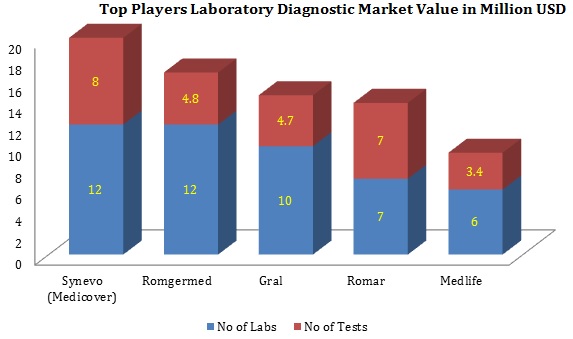
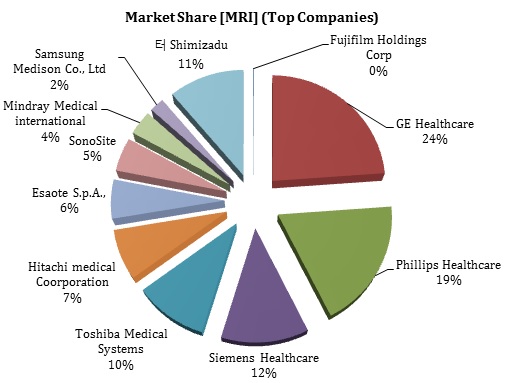
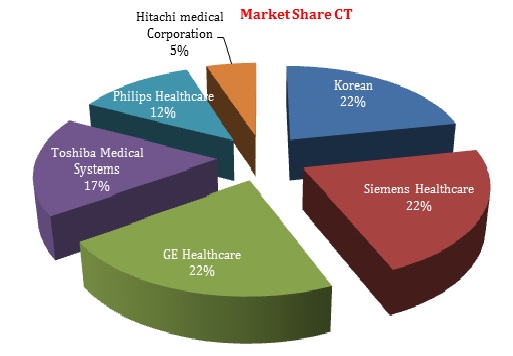
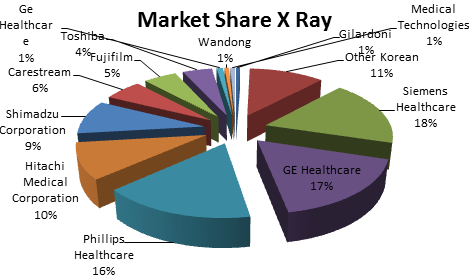
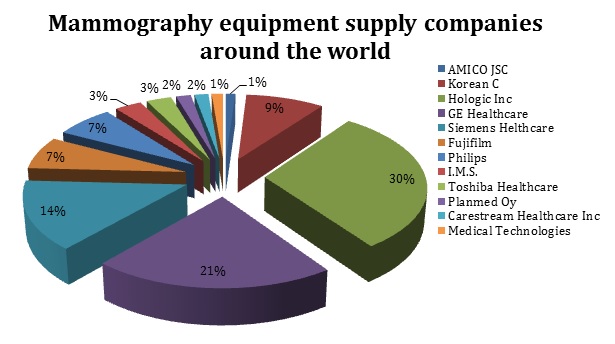

Radiology information systems (RIS)
Radiology information systems (RIS) are considered to be one of the basic systems for electronic management of all the imaging departments. Within a radiology department, RIS helps in scheduling patient appointments, managing resources, tracking examination performance, providing examination explanations, ensuring proper distribution of results, and enabling procedure billing.
On the basis of type, the global radiology information systems market is segmented into integrated RIS and standalone RIS. The Integrated RIS segment dominated the global radiology information systems market in 2014, and is estimated to reach $537.1 million by 2019.
Based on components, the market is categorized into services, software, and hardware. In 2014, the services segment accounted for the largest share of the global radiology information systems market, and is projected to reach $272.2 million by 2019. On the basis of deployment mode, the market is categorized into web-based, on-premise, and cloud-based. The web-based segment accounted for the largest share of the global radiology information systems market, and is projected to reach $450.6 million by 2019.
The key players operating in this market are Cerner Corporation (U.S.), McKesson Corporation (U.S.), Siemens Healthcare AG (Germany), Merge Healthcare (U.S.), Allscripts (U.S.), GE Healthcare (U.K.), Philips Healthcare (Netherlands), and Epic Systems (U.S.).
Digital radiology Market
Digital radiology offers a plethora of benefits such as accurate and high-quality images, flexibility in image management, superior evaluation of images and data, reduced exposure to radiation, and improved patient turnouts. These factors have made digital radiology more popular compared to computed radiology. With increasing demand for digital radiography equipment, the competition has increased, leading to a decline in prices. Digital radiology has become more affordable and is being used in a wide-range of applications. Increasing R&D activities in Mexico, along with government initiatives, has further propelled the Mexico digital radiology market.
However, despite digital radiology becoming more affordable in recent years, its cost of initial installation and outlay cost is extremely high. This limits its penetration in smaller clinics and medical centers, and restricts the overall growth of the market. Moreover, digital radiography rooms require to undergo complete renovations, forcing buyers to opt for computed radiography systems in the interim period.
Products manufactured by the industry related Radiology Research and it’s market Value.
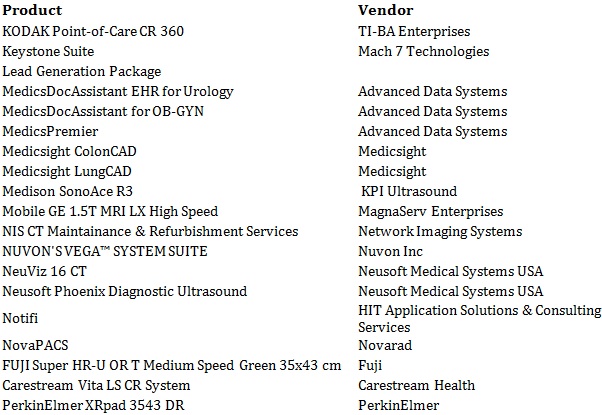
Fund Allotment to Radiology Research
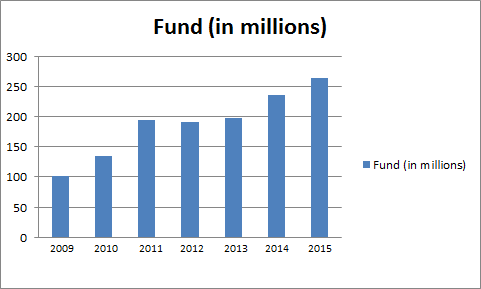
1. Every $100 million invested in research by the National Institutes of Health, according to the R&D consulting firm Battelle, generates almost six patents.
2. At the National Science Foundation $100 million generates more than 10.
3. At the National Institute of Biomedical Imaging and Bioengineering — which finances research in radiology — it produces almost 25 patents.
4. And these patents sparked $578.2 million worth of additional R&D further downstream.
Statistics of Physicians, Researchers and Academicians working on Radiology
1. A Radiologist earns about $351,000 being the 6th highest earner amongst other specializers.
2. When 2014 compensation is compared with the prior years, radiologists reported an increase of 3%
3. There are approximately 1,900 radiology groups today, down from approximately 2,100 just three years ago
4. If we look at the demographics, by 2030, it's estimated that 40% of the population will have some type of cardiovascular disease, 8 million more people will have coronary heart disease, and 4 million more will have strokes. Radiology will play a big role in the management of those diseases," Beauchamp said. "Reimbursement per study will probably go down, but I think in some ways that's a good thing. Specifically, the value of imaging is clearly there, but we do have to make it more affordable if we are to continue to be asked to contribute to patient care."
5. The Royal Australian and New Zealand College of Radiologists (RANZCR) estimates that in 2012 IN Australia, 1761 radiologists service a population of 22.86 million.
6. New Zealand has 319 active radiologists serving a population of approximately 4.4 million.
7. The Number of Australian radiologists in training has increased from 200 in the year 2000 to almost 400 in the year 2012
8. Numbers from the American College of Radiology suggests, there were about 1,100 fellows competing for approximately 1,115 open positions in 2014.
Conference Highlights
- Industrial Forum: Radiology
- Radiology Trends and Technology
- Radiographic Testing
- Breast Radiography
- PET/MRI versus PET/CT Hybrid
- Medical Imaging
- Magnetic Resonance Imaging
- Ultrasound
- Mammography
- Radiation Oncology
- Advances in Cancer Detection
- Neuroradiology and Neuroimaging
- Nursing Practice and Radiation Oncology Nursing
To share your views and research, please click here to register for the Conference.
To Collaborate Scientific Professionals around the World
| Conference Date | September 19-20, 2016, | ||
| Sponsors & Exhibitors |
|
||
| Speaker Opportunity Closed | Day 1 | Day 2 | |
| Poster Opportunity Closed | Click Here to View | ||
Useful Links
Special Issues
All accepted abstracts will be published in respective Our International Journals.
- OMICS Journal of Radiology
- Journal of Imaging and Interventional Radiology
- Insights in Medical Physics
Abstracts will be provided with Digital Object Identifier by












